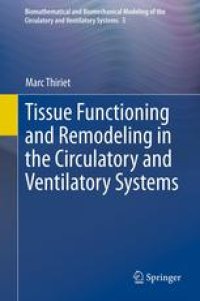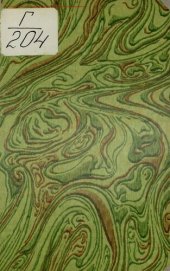
Ebook: Tissue Functioning and Remodeling in the Circulatory and Ventilatory Systems
Author: Marc Thiriet (auth.)
- Tags: Biophysics and Biological Physics, Biomedical Engineering, Mathematical and Computational Biology, Systems Biology, Engineering Fluid Dynamics, Cardiology
- Series: Biomathematical and Biomechanical Modeling of the Circulatory and Ventilatory Systems 5
- Year: 2013
- Publisher: Springer-Verlag New York
- Edition: 1
- Language: English
- pdf
The volumes in this authoritative series present a multidisciplinary approach to modeling and simulation of flows in the cardiovascular and ventilatory systems, especially multiscale modeling and coupled simulations. Volume 5 is devoted to cells, tissues, and organs of the cardiovascular and ventilatory systems with an emphasis on mechanotransduction-based regulation of flow. The blood vessel wall is a living tissue that quickly reacts to loads applied on it by the flowing blood. In any segment of a blood vessel, the endothelial and smooth muscle cells can sense unusual time variations in small-magnitude wall shear stress and large-amplitude wall stretch generated by abnormal hemodynamic stresses. These cells respond with a short-time scale (from seconds to hours) to adapt the vessel caliber. Since such adaptive cell activities can be described using mathematical models, a key objective of this volume is to identify the mesoscopic agents and nanoscopic mediators required to derive adequate mathematical models. The resulting biomathematical models and corresponding simulation software can be incorporated into platforms developed in virtual physiology for improved understanding and training.
The volumes in this authoritative series present a multidisciplinary approach to modeling and simulation of flows in the cardiovascular and ventilatory systems, especially multiscale modeling and coupled simulations. Volume 5 is devoted to cells, tissues, and organs of the cardiovascular and ventilatory systems with an emphasis on mechanotransduction-based regulation of flow. The blood vessel wall is a living tissue that quickly reacts to loads applied on it by the flowing blood. In any segment of a blood vessel, the endothelial and smooth muscle cells can sense unusual time variations in small-magnitude wall shear stress and large-amplitude wall stretch generated by abnormal hemodynamic stresses. These cells respond with a short-time scale (from seconds to hours) to adapt the vessel caliber. Since such adaptive cell activities can be described using mathematical models, a key objective of this volume is to identify the mesoscopic agents and nanoscopic mediators required to derive adequate mathematical models. The resulting biomathematical models and corresponding simulation software can be incorporated into platforms developed in virtual physiology for improved understanding and training.
Reviews structure and function of major constituents of the circulatory and respiratory apparatus
Describes major cellular processes involved in signaling, interactions, and adaptive responses of physiological conduits
Integrates biology, chemistry, and physics for the multidisciplinary exploration and modeling of physiological flows
Focuses on mechanotransduction-induced regulation
The volumes in this authoritative series present a multidisciplinary approach to modeling and simulation of flows in the cardiovascular and ventilatory systems, especially multiscale modeling and coupled simulations. Volume 5 is devoted to cells, tissues, and organs of the cardiovascular and ventilatory systems with an emphasis on mechanotransduction-based regulation of flow. The blood vessel wall is a living tissue that quickly reacts to loads applied on it by the flowing blood. In any segment of a blood vessel, the endothelial and smooth muscle cells can sense unusual time variations in small-magnitude wall shear stress and large-amplitude wall stretch generated by abnormal hemodynamic stresses. These cells respond with a short-time scale (from seconds to hours) to adapt the vessel caliber. Since such adaptive cell activities can be described using mathematical models, a key objective of this volume is to identify the mesoscopic agents and nanoscopic mediators required to derive adequate mathematical models. The resulting biomathematical models and corresponding simulation software can be incorporated into platforms developed in virtual physiology for improved understanding and training.
Reviews structure and function of major constituents of the circulatory and respiratory apparatus
Describes major cellular processes involved in signaling, interactions, and adaptive responses of physiological conduits
Integrates biology, chemistry, and physics for the multidisciplinary exploration and modeling of physiological flows
Focuses on mechanotransduction-induced regulation
Content:
Front Matter....Pages i-xxi
Blood....Pages 1-18
Hematopoiesis....Pages 19-52
Blood Cells....Pages 53-175
Lymph Drainage....Pages 177-187
Cardiomyocytes....Pages 189-269
Heart Wall....Pages 271-348
Vessel Wall....Pages 349-380
Smooth Myocytes....Pages 381-452
Vascular Endothelium....Pages 453-603
Vasculature Growth....Pages 605-673
Tissue Development, Repair, and Remodeling....Pages 675-747
Airway Surface Liquid and Respiratory Mucus....Pages 749-787
Surfactant....Pages 789-804
Conclusion....Pages 805-812
Back Matter....Pages 813-962
The volumes in this authoritative series present a multidisciplinary approach to modeling and simulation of flows in the cardiovascular and ventilatory systems, especially multiscale modeling and coupled simulations. Volume 5 is devoted to cells, tissues, and organs of the cardiovascular and ventilatory systems with an emphasis on mechanotransduction-based regulation of flow. The blood vessel wall is a living tissue that quickly reacts to loads applied on it by the flowing blood. In any segment of a blood vessel, the endothelial and smooth muscle cells can sense unusual time variations in small-magnitude wall shear stress and large-amplitude wall stretch generated by abnormal hemodynamic stresses. These cells respond with a short-time scale (from seconds to hours) to adapt the vessel caliber. Since such adaptive cell activities can be described using mathematical models, a key objective of this volume is to identify the mesoscopic agents and nanoscopic mediators required to derive adequate mathematical models. The resulting biomathematical models and corresponding simulation software can be incorporated into platforms developed in virtual physiology for improved understanding and training.
Reviews structure and function of major constituents of the circulatory and respiratory apparatus
Describes major cellular processes involved in signaling, interactions, and adaptive responses of physiological conduits
Integrates biology, chemistry, and physics for the multidisciplinary exploration and modeling of physiological flows
Focuses on mechanotransduction-induced regulation
Content:
Front Matter....Pages i-xxi
Blood....Pages 1-18
Hematopoiesis....Pages 19-52
Blood Cells....Pages 53-175
Lymph Drainage....Pages 177-187
Cardiomyocytes....Pages 189-269
Heart Wall....Pages 271-348
Vessel Wall....Pages 349-380
Smooth Myocytes....Pages 381-452
Vascular Endothelium....Pages 453-603
Vasculature Growth....Pages 605-673
Tissue Development, Repair, and Remodeling....Pages 675-747
Airway Surface Liquid and Respiratory Mucus....Pages 749-787
Surfactant....Pages 789-804
Conclusion....Pages 805-812
Back Matter....Pages 813-962
....


















